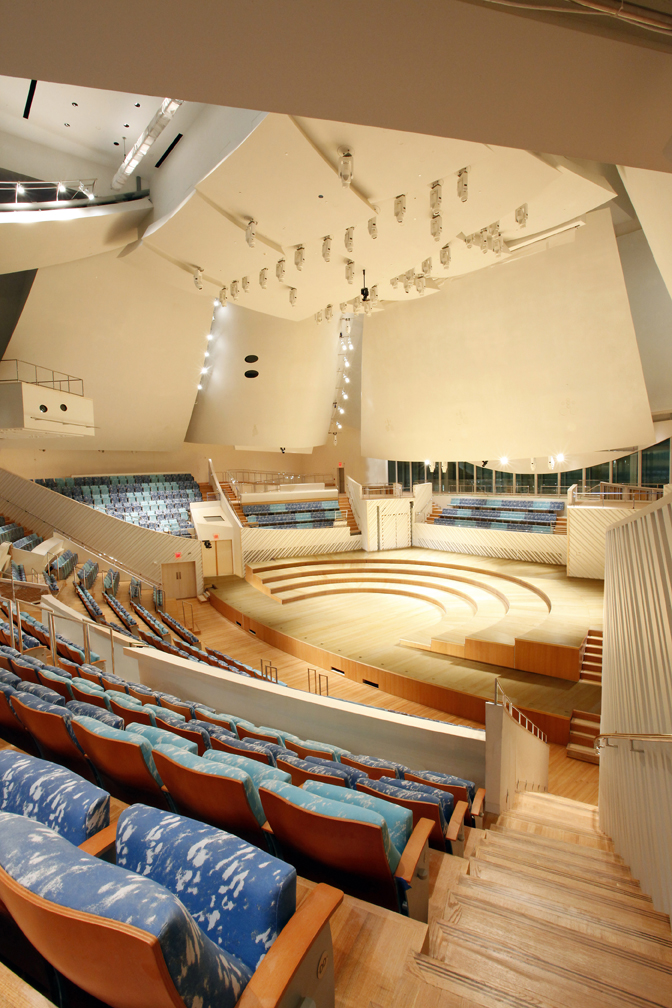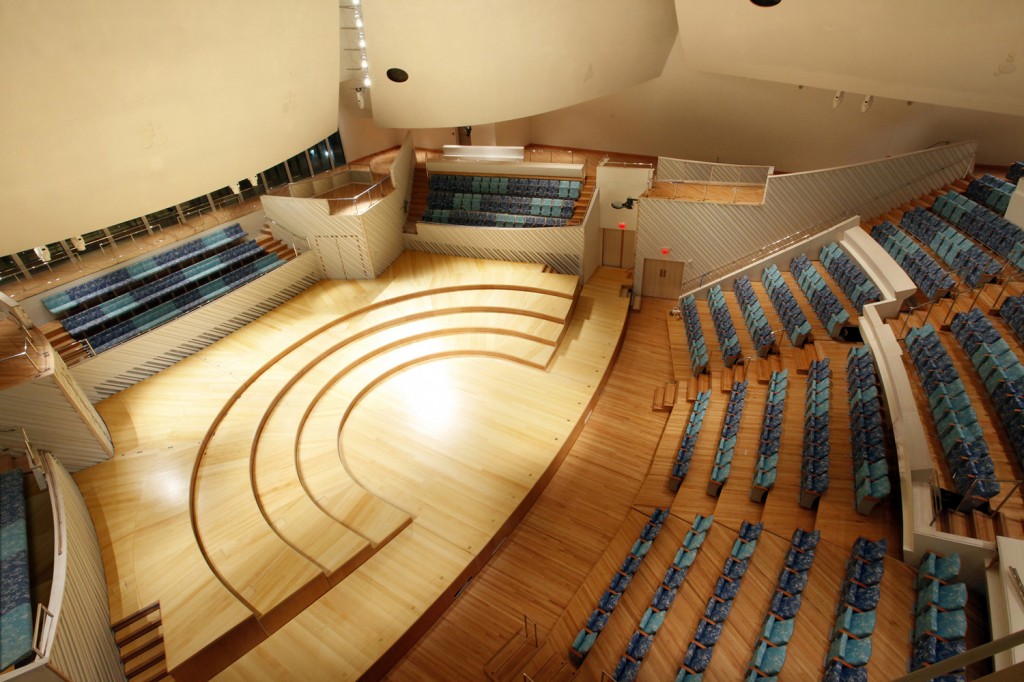New World Symphony to create new multimedia world in Gehry hall

Photo: Rui Dias-Aidos (REDAV)
The recorded music of Thomas Adès thunders through the hall, as five eccentrically shaped video screens above the stage display images of crashing waves, volcanic rocks and a running woman.
Seated in the middle of a steeply stacked tier of aqua and blue seats is Michael Tilson Thomas, the New World Symphony’s founder and artistic director, and the video artist Tal Rosner, working on a multimedia piece that will help inaugurate the orchestra’s stylish and innovative new home next week.
On Wednesday Tilson Thomas will raise his baton to call up the bracing opening bars of Wagner’s Overture to The Flying Dutchmen in front of an audience liberally sprinkled with the VIPs of the classical world, including several leading national critics, the chairman of the National Endowment for the Arts, and executive directors of several major orchestras.
The orchestra leaders are likely to be particularly interested in the new hall’s innovations. The symphonic world is one of graying audiences, deficits and a feeling that classical music has fallen hopelessly behind film, theater, the visual arts and the internet in generating excitement among the public.
The New World’s new campus is designed to aggressively take on these problems, conceived as a part of the Lincoln Road nightlife district, embracing the use of video, using glass walls to open practice areas to public view and attempting to offer inviting alternatives to the traditional formal concert experience that has dominated the classical world for centuries.
“What we’re trying to do is make classical music accessible and to innovate, and this whole building encourages that,” said Adriana Horne, 31, the orchestra’s harpist. “Walking through the building, it feels like an art gallery for music. You see music being created. The harp practice room faces the parking garage, and I’ve noticed as people get out of their cars they look over at me. There are so many ways to see in, the whole building invites curiosity.”
Rather than presenting the impressive, somewhat forbidding facade of many big concert halls, the New World was designed to eliminate the entrance barriers that keep out casual strollers and members of the public who might be tempted to check out a concert if the whole enterprise wasn’t so intimidating.

Photo by Rui Dias-Aidos (REDAV)
The atrium will be open to the public. The front of the building consists largely of a clear glass wall, with one of the large rehearsal spaces completely open to view. A projection wall will show a constantly changing program of films and images from concerts. The idea is to invite people to wander in, without having bought a ticket or knowing when a concert is scheduled, just to check out what’s going on inside.
The hall will also allow the New World to try different formats – casual mini-concerts repeated a few times an evening, in-depth journey concerts focusing on a particular composer’s work for orchestra, chamber and other ensembles, and rehearsals projected on the outside wall.
“We wanted to lower the threshold of entry, cut the elitism of the institution,” said Craig Webb, the architect at Gehry’s firm in charge of the project. “Michael’s bigger agenda is to figure out how to expand his audience, which is why it’s located in South Beach. He’s really trying to tap the energy and excitement of Lincoln Road nightlife.”
Tilson Thomas has been busy attending meetings on many matters large and small, trying out the indoor and outdoor sound systems, preparing the first week of concerts and working out the acoustics.
“It’s an exciting journey,” he said. “We’re very excited to think, my gosh, we’re actually opening it. It’s a great addition to the city, and it’s extraordinary to think that classical music is actually at the center of something like this.”
The acoustics of the new hall are a work in progress. Tilson Thomas is trying out various panels and configurations of the orchestra. “It’s a very big, rich sound,” he said. “You’re going to be amazed. We knew the room’s sound would be big. It’s just a matter of shaping it.”
The new campus, located next to the orchestra’s old home at the Lincoln Theatre, bristles with technology to a degree that’s unusual even among contemporary performing arts centers.
Practice rooms are equipped with flat video screens and the orchestra’s Internet2 system, which allows a fellow or an orchestral section in Miami to be coached in real time by a professional in, say, New York, Boston or Berlin. In the main hall, looking down over the seats, is an audio-visual control booth that looks like it belongs in the AmericanAirlines Arena. The booth controls computer-operated video projectors capable of conforming their images to the oddly shaped screens of the main hall.
A new city park has been built as part of the campus, containing powerful projectors and speakers that will allow up to 1,000 people to experience performances. It was on many of these technological wonders that the orchestra’s management has focused as they prepared the hall for its opening next week.
“One of the biggest challenges is the technology of the building, in making it perform at the highest possible level,” said Howard Herring, the orchestra’s executive director. “We pushed it as hard as we could push it, and if there’s a glitch, we fix it.”
In rigorous testing of the outdoor projection system, which will project films, concerts and other images on the a wall facing the park, they headed off one potential catastrophe. The projectors, it turned out, had a tendency to shut down when the temperature rose above a certain level. Now they’ve learned to keep the air conditioning up to prevent that. “The physical requirements of all this technology are extraordinary,” Herring said.
The concert hall itself is a much more intimate, yet clearly contemporary space. More vertical than most halls, with their vast fields of seats, the New World’s hall stacks the audience in tiers that keep listeners close to the orchestra. The farthest seat is only 13 rows back. Although there’s clearly a front of the hall, rows of seats rise on all sides of the orchestra, with the seats behind the orchestra coming right up to the percussion section.
Small platforms—most used for audience seating when not required by the orchestra—jut out into the hall, providing space for smaller ensembles. These will be used next Thursday for the orchestra’s second concert, A Schubert Journey, in which the program will swiftly alternate between the composer’s orchestral, chamber and vocal works.
A hall that embraces technology to this extent is bound to raise questions about whether the video, the gadgets and the flash will elbow the music out of the way. Herring insists this won’t happen, and he offers an example.
On January 30 the orchestra will perform Mussorgsky’s Pictures at an Exhibition, accompanied by short movies by film students at the University of Southern California. Ordinarily, Herring said, when music accompanies films, the conductor will conform the playing of the music to the pace of the video, following what’s called a click track to synchronize the two elements of the performance. But Herring says, “We’re flipping that around.” The music will be performed freely, with the conductor in control. In the video booth will be two technicians, one following the score and giving instructions to the person in control of the films as to when to switch to the next segment.
The $160 million hall has already been paid for, with money coming from the City of Miami Beach, Miami-Dade County and private donors. The city paid the $30 million cost of the parking garage and park. The annual operating costs will rise from $9 million at the Lincoln Theatre to $12 million, primarily because the new campus has nearly three times the space of the old one. Other groups will also be using the hall, which the orchestra is eager to rent out. Julian Kreeger’s Friends of Chamber Music of Miami, for example, will hold a concert in the hall’s ground-floor SunTrust Pavilion, a large rehearsal room that seats 170.
“So often in classical music the audience only sees the finished product,” says harpist Horne. “I think that’s very removing, in a way. I think this whole space is inspiring.”
Michael Tilson Thomas leads the New World Symphony in the inaugural concert at New World Center Wednesday January 26. The program consists of Wagner’s Overture to The Flying Dutchman, Copland’s Symphony No. 3 and the world premiere of Thomas Adès’ Polaris. nws.edu; 305-673-3331.